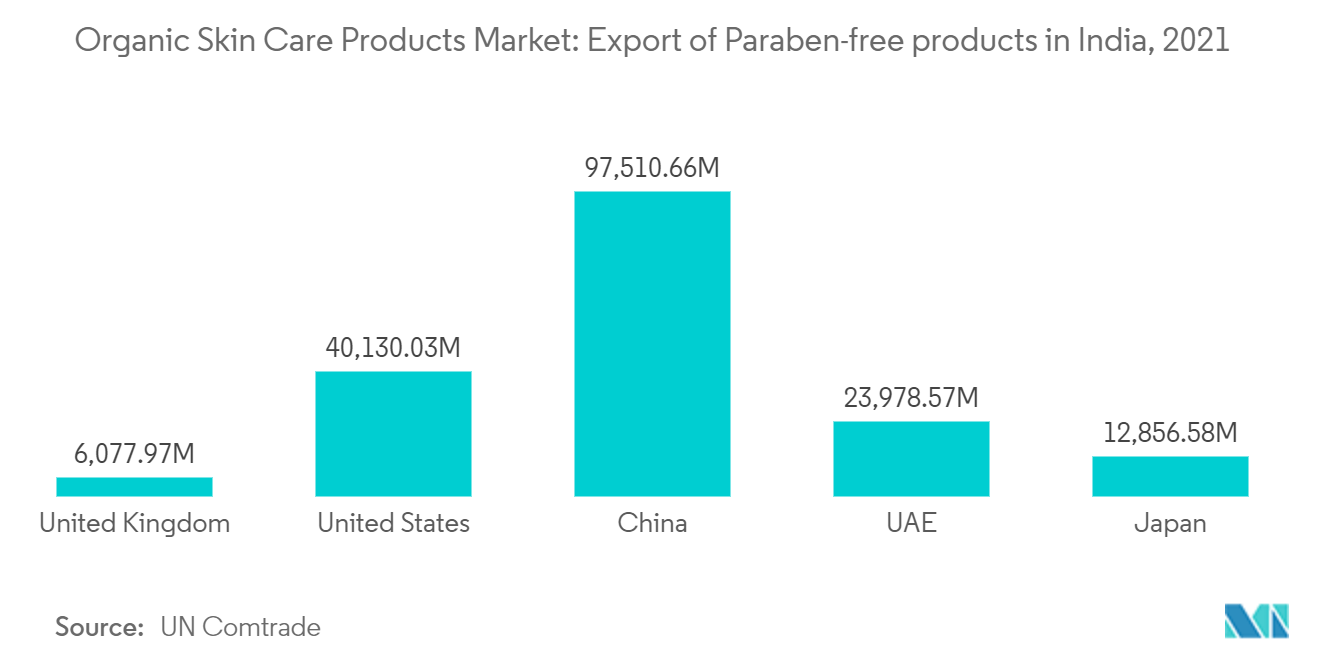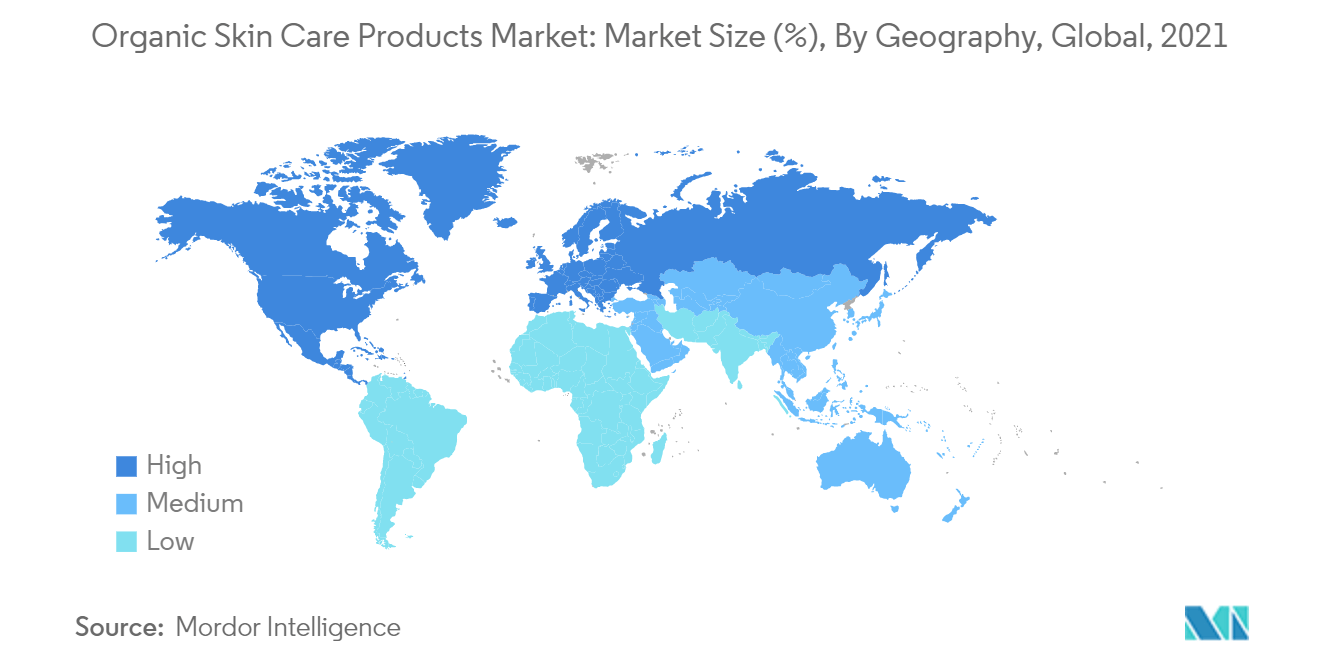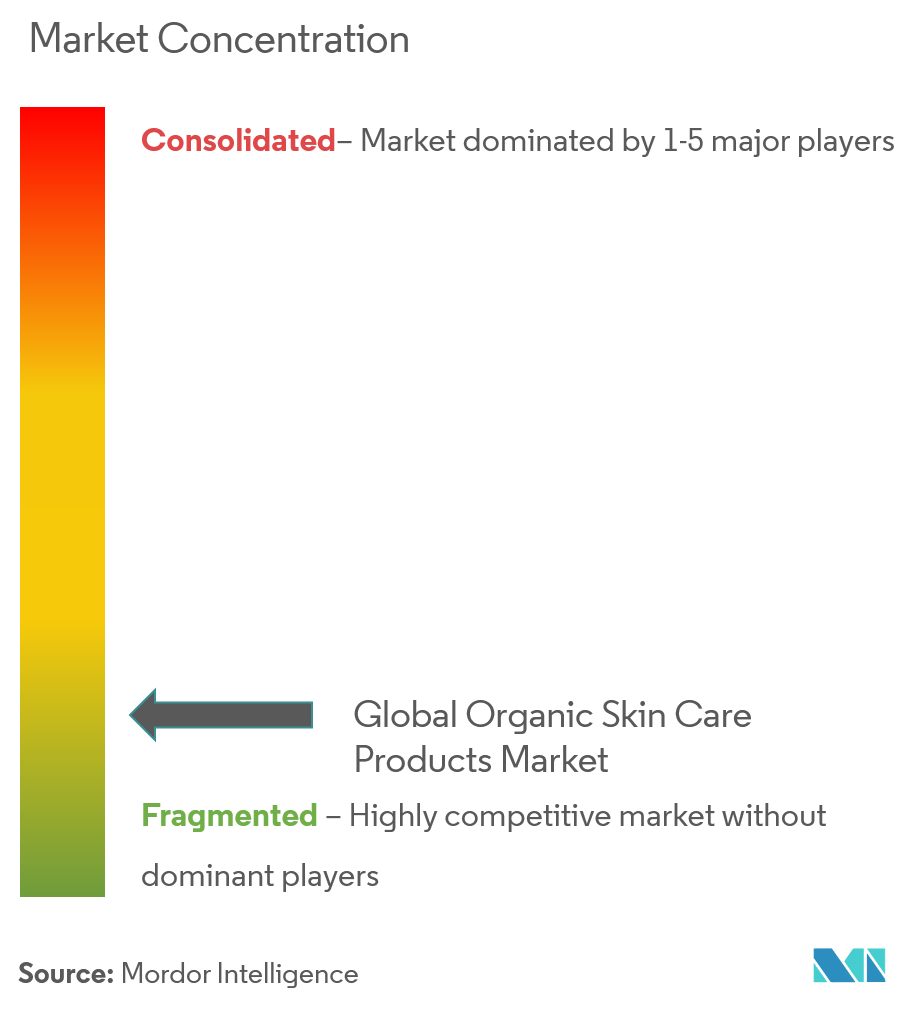Organic Skincare Products Market Size

| Study Period | 2019 - 2029 |
| Market Size (2024) | USD 8.50 Billion |
| Market Size (2029) | USD 13.76 Billion |
| CAGR (2024 - 2029) | 10.11 % |
| Fastest Growing Market | Asia Pacific |
| Largest Market | North America |
| Market Concentration | Low |
Major Players
*Disclaimer: Major Players sorted in no particular order |
Organic Skincare Products Market Analysis
The Organic Skincare Products Market size is estimated at USD 8.5 billion in 2024, and is expected to reach USD 13.76 billion by 2029, growing at a CAGR of 10.11% during the forecast period (2024-2029).
Skincare is an essential part of personal care. It includes everything from correction to prevention in the makeup process. The innovations and developments in the beauty industry promise to deliver improved products with a health-friendly touch. Makeup with skincare benefits has been prevalent in the market for quite a while now. Skin sensitivity and awareness about the harmful effects of chemicals and synthetic products are some factors driving the growth of the organic and natural skincare products market. Most of the consumer base tends to buy products with the terms natural or organic associated with them. They generally do not focus on the ingredients used in the product's manufacturing.
The presence of harmful chemicals in beauty and face creams can cause rashes and allergies because of skin sensitivity issues. Excessive use of makeup daily may cause wrinkles on the skin, and it becomes rough and loses natural hyaluronic acid. These are some factors increasing the preference for organic products containing less harmful chemicals and more benefits from natural ingredients. Although women's skin care products are abundant in the market, the demand for men's skincare products is also gaining traction with growing awareness. Environmental factors, like pollution and UV rays, can damage skin cells and causes acne. Organic products reduce acne and protect the skin from harmful UV rays. Such factors are expected to augment the growth of the organic skincare products market over the next five years.
Organic Skincare Products Market Trends
This section covers the major market trends shaping the Organic Skincare Products Market according to our research experts:
Paraben-free Products are Being Increasingly Launched
Parabens are the most widely used preservatives in cosmetics and pharmaceutical products. Consumers are becoming more concerned about avoiding parabens as an ingredient in their skincare products as they have many side effects. They can disrupt hormones in the body and also cause skin irritation. With the growth of organic products, synthetic compounds like propylparaben and butylparaben are not considered safe. If a product is paraben-free, the label will typically show "free from parabens." Labels stating Isopropylparaben and isobutylparaben also indicate the absence of parabens. For the beauty industry, many categories still derive a significant share of sales from products with parabens and other undesirable ingredients. However, those categories are shifting to paraben-free skincare products. In January 2021, Renee Cosmetics launched premium face oils. the product is FDA- approved and claims to be crulty-free, paraben-free, and organic.

Asia-Pacific Registering the Highest Growth Rate
Asia-Pacific is one of the most diverse and dynamic markets in the cosmetic industry across the world in terms of many popular categories, such as skin care, sun care, hair care, color cosmetics, deodorants, and fragrances, which are the most commonly used in this region. Hence, the region remains a potential market for organic skincare products worldwide. The Asia-Pacific region is expected to witness the fastest growth during the forecast period. An aging population, increasing awareness of organic products, an increasing number of millennials and more working women are the driving factors for organic skincare in this region. The market players are also encouraging consumers to buy organic products through advertising and promotions. They are expanding their portfolios in the market considering the demand for it. For instance, in June 2022, a leading skin care brand Samisha Organic launched new skin care products in Indian market. The products include moisturizers, foot care creams, face wash, and hair & nail care creams. Also, with increasing investments toward branding and advertising organic skincare products in the region, this market is expected to flourish during the forecast period. Moreover, in Asia-Pacific, China dominates the market studied, followed by Japan, South Korea, and others.

Organic Skincare Products Industry Overview
The global organic skincare products market is highly competitive. It comprises regional and international competitors such as The Hain Celestial Group (Avalon Natural Products Inc.), L'Oréal SA, Johnson & Johnson, and others. The major market strategies adopted by the companies are new product launches, agreements/partnerships, expansions, mergers, and acquisitions. Companies are adopting merger and acquisition strategies to utilize their respective key strengths, such as intense R&D activities, distribution network, and the development of new products to enhance the portfolio, capture the untapped markets and drive the organic skincare products market further.
Organic Skincare Products Market Leaders
-
Johnson & Johnson
-
Botanic Organic, LLC
-
Eminence Organic Skin Care
-
Loreal SA
-
The Hain Celestial Group (Avalon Organics)
*Disclaimer: Major Players sorted in no particular order

Organic Skincare Products Market News
- September 2022: Naturals Skincare products launched its new beauty care products brand 'Pearl'. The Pearl company launched 18 new chemical-free organic beauty products for skin and hair care.
- February 2022: Honasa Consumer Pvt. Ltd launched a new skincare brand called Ayuga based on ayurvedic recipes. The products of Ayuga are completely organic, and Ayurveda-based herbs are used in those products.
- December 2021: Loreal signed an agreement to acquire Youth to the People, an American skincare company based in California. The reason behind the acquisition was to create health-conscious vegan-based skin care products.
Organic Skincare Products Market Report - Table of Contents
1. INTRODUCTION
1.1 Study Assumptions and Market Definition
1.2 Scope of the Study
2. RESEARCH METHODOLOGY
3. EXECUTIVE SUMMARY
4. MARKET DYNAMICS
4.1 Market Drivers
4.2 Market Restraints
4.3 Porter's Five Forces Analysis
4.3.1 Threat of New Entrants
4.3.2 Bargaining Power of Buyers/Consumers
4.3.3 Bargaining Power of Suppliers
4.3.4 Threat of Substitute Products
4.3.5 Intensity of Competitive Rivalry
5. MARKET SEGMENTATION
5.1 Type
5.1.1 Facial Care
5.1.1.1 Cleansers
5.1.1.2 Moisturizers and Oils/Serums
5.1.1.3 Other Facial Care Products
5.1.2 Body Care
5.1.2.1 Body Lotions
5.1.2.2 Body Wash
5.1.2.3 Other Body Care Products
5.2 Distribution Channel
5.2.1 Supermarkets/Hypermarkets
5.2.2 Convenience Stores
5.2.3 Specialist Stores
5.2.4 Online Retail Stores
5.2.5 Other Distribution Channels
5.3 Geography
5.3.1 North America
5.3.1.1 United States
5.3.1.2 Canada
5.3.1.3 Mexico
5.3.1.4 Rest of North America
5.3.2 Europe
5.3.2.1 United Kingdom
5.3.2.2 Germany
5.3.2.3 Spain
5.3.2.4 France
5.3.2.5 Italy
5.3.2.6 Russia
5.3.2.7 Rest of Europe
5.3.3 Asia-Pacific
5.3.3.1 China
5.3.3.2 Japan
5.3.3.3 India
5.3.3.4 Australia
5.3.3.5 Rest of Asia-Pacific
5.3.4 South America
5.3.4.1 Brazil
5.3.4.2 Argentina
5.3.4.3 Rest of South America
5.3.5 Middle East and Africa
5.3.5.1 United Arab Emirates
5.3.5.2 South Africa
5.3.5.3 Rest of Middle East and Africa
6. COMPETITIVE LANDSCAPE
6.1 Most Adopted Strategies
6.2 Market Share Analysis
6.3 Company Profiles
6.3.1 The Hain Celestial Group (Avalon Organics)
6.3.2 Jhonson & Jhonson
6.3.3 Starflower Essential Organic Skin Care
6.3.4 Thesis Beauty
6.3.5 Eminence Organic Skin Care
6.3.6 Botanic Organic LLC
6.3.7 Phyt's USA
6.3.8 L'Oreal SA (Garnier)
6.3.9 Forrest Essentials
6.3.10 Honasa Consumer Pvt. Ltd (Ayuga, Mamaearth)
6.3.11 Naturals Skincare (Pearl)
- *List Not Exhaustive
7. MARKET OPPORTUNITIES AND FUTURE TRENDS
Organic Skincare Products Industry Segmentation
Organic skincare products are generally defined as products containing organically grown ingredients free from pesticides. The organic skincare products market is segmented by product type, distribution channel, and geography. Based on product type, the market is segmented into facial care (cleansers, moisturizers and oils/serums, and other facial care products) and body care (body lotions, body wash, and other body care products). By distribution channel, the market is segmented into supermarkets/hypermarkets, specialty retail stores, online retail stores, and other distribution channels. By geography, the market is segmented into North America (United States, Canada, Mexico, and Rest of North America), Europe (United Kingdom, Germany, Spain, France, Italy, Russia, and Rest of Europe), Asia-Pacific (China, Japan, India, Australia, and Rest of Asia-Pacific), South America (Brazil, Argentina, and Rest of South America), and Middle East and Africa (United Arab Emirates, South Africa, and Rest of Middle East and Africa). For each segment, the market sizing and forecasts have been done on the basis of value (in USD million).
| Type | |||||
| |||||
|
| Distribution Channel | |
| Supermarkets/Hypermarkets | |
| Convenience Stores | |
| Specialist Stores | |
| Online Retail Stores | |
| Other Distribution Channels |
| Geography | |||||||||
| |||||||||
| |||||||||
| |||||||||
| |||||||||
|
Organic Skincare Products Market Research FAQs
How big is the Organic Skincare Products Market?
The Organic Skincare Products Market size is expected to reach USD 8.50 billion in 2024 and grow at a CAGR of 10.11% to reach USD 13.76 billion by 2029.
What is the current Organic Skincare Products Market size?
In 2024, the Organic Skincare Products Market size is expected to reach USD 8.50 billion.
Who are the key players in Organic Skincare Products Market?
Johnson & Johnson, Botanic Organic, LLC , Eminence Organic Skin Care, Loreal SA and The Hain Celestial Group (Avalon Organics) are the major companies operating in the Organic Skincare Products Market.
Which is the fastest growing region in Organic Skincare Products Market?
Asia Pacific is estimated to grow at the highest CAGR over the forecast period (2024-2029).
Which region has the biggest share in Organic Skincare Products Market?
In 2024, the North America accounts for the largest market share in Organic Skincare Products Market.
What years does this Organic Skincare Products Market cover, and what was the market size in 2023?
In 2023, the Organic Skincare Products Market size was estimated at USD 7.72 billion. The report covers the Organic Skincare Products Market historical market size for years: 2019, 2020, 2021, 2022 and 2023. The report also forecasts the Organic Skincare Products Market size for years: 2024, 2025, 2026, 2027, 2028 and 2029.
What are the key challenges in marketing Organic Skincare Products?
The key challenges in marketing Organic Skincare Products are a) Educating consumers b) Addressing price perceptions c) Competing with established brands
Organic Beauty Products Industry Report
The global organic skin care market is on the rise, fueled by consumers' growing preference for chemical-free beauty products. This trend is supported by the increasing awareness of the benefits of organic ingredients in products like creams, serums, and moisturizers, which are seen as safer and more effective than synthetic alternatives. The market's expansion is further propelled by a demographic shift, with millennial men showing a keen interest in organic skin care, prompting companies to broaden their product ranges. Additionally, the shift towards online sales and the emphasis on innovation and sustainability in product development are key factors driving market growth. Organic skin care companies are investing in research and development to launch products that meet consumer demands for efficacy, environmental friendliness, and sustainability. With the market's evolution, distribution channels are diversifying, enhancing accessibility to organic skin care solutions. For detailed insights, Mordor Intelligence™ offers comprehensive analysis and forecasts on market share, size, and revenue growth rates, available for download as a free report PDF.



